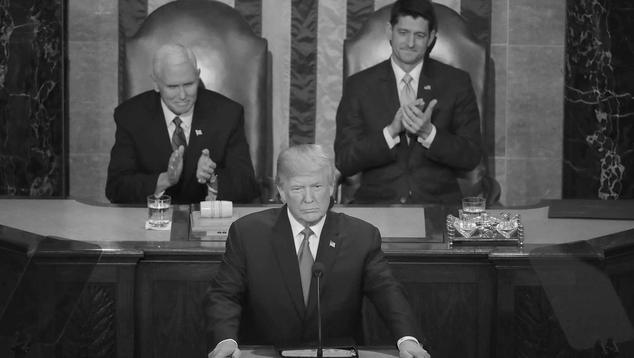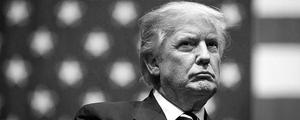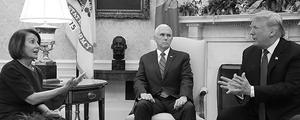WASHINGTON, D.C. -- As President Donald Trump prepares to give the State of the Union address, he is hoping to reap some political benefit from it, as has occurred after the past three such addresses. Trump, in 2018, and Barack Obama, in 2015 and 2016, saw modest two- to four-percentage-point increases in approval after their State of the Union addresses. Historically, however, it has been rare for presidents' approval to rise after their State of the Union speeches.
| President | Pre-Speech | Post-Speech | Change | ||||||||||||||||||||||||||||||||||||||||||||||||||||||||||||||||||||||||||||||||||||||||||||||||
|---|---|---|---|---|---|---|---|---|---|---|---|---|---|---|---|---|---|---|---|---|---|---|---|---|---|---|---|---|---|---|---|---|---|---|---|---|---|---|---|---|---|---|---|---|---|---|---|---|---|---|---|---|---|---|---|---|---|---|---|---|---|---|---|---|---|---|---|---|---|---|---|---|---|---|---|---|---|---|---|---|---|---|---|---|---|---|---|---|---|---|---|---|---|---|---|---|---|---|---|
| % Approve | % Approve | ||||||||||||||||||||||||||||||||||||||||||||||||||||||||||||||||||||||||||||||||||||||||||||||||||
| 2018 | Trump | 38 | 40 | +2 | |||||||||||||||||||||||||||||||||||||||||||||||||||||||||||||||||||||||||||||||||||||||||||||||
| 2016 | Obama | 45 | 49 | +4 | |||||||||||||||||||||||||||||||||||||||||||||||||||||||||||||||||||||||||||||||||||||||||||||||
| 2015 | Obama | 45 | 48 | +3 | |||||||||||||||||||||||||||||||||||||||||||||||||||||||||||||||||||||||||||||||||||||||||||||||
| 1978-2014 average | 54 | 54 | 0 | ||||||||||||||||||||||||||||||||||||||||||||||||||||||||||||||||||||||||||||||||||||||||||||||||
| Gallup | |||||||||||||||||||||||||||||||||||||||||||||||||||||||||||||||||||||||||||||||||||||||||||||||||||
This analysis is based on a comparison of the last Gallup poll conducted before each president's State of the Union address and the first poll conducted entirely after it. The data for all 35 speeches are shown at the bottom of the article. The timing of the pre-speech and post-speech polls has varied, but they typically have been conducted within one or two weeks of the address. First-year presidents, including Trump in 2017, often give addresses before joint sessions of Congress, but those are not considered official State of the Union addresses and therefore are not included in this analysis.
Across the 35 State of the Union speeches since 1978, the president's approval rating has, on average, increased by 0.2 points. In seven instances, approval rose by three or more percentage points; in seven, it declined by at least that amount; and in the rest, there was less movement.
Recent State of the Union addresses have had a more consistently positive impact for the president. A year ago, Trump was able to tout gains in the economy and stock market during his 2018 State of the Union. His job approval rating ticked up to 40% in Gallup tracking polling conducted from Jan. 29-Feb. 4, partially before and partially after the Jan. 30 speech, but stayed at 40% in the first full week of polling after the address. Those were his first approval ratings in the 40s in eight months, dating back to May 2017.
Obama -- whose approval ratings were generally flat after his first several States of the Union -- saw increases of three points in 2015 and four points in 2016 in the days immediately afterward. But that polling may understate the boost Obama got in each of those years, as his approval rating pushed even higher in subsequent days of Gallup Daily tracking. In 2016, his approval rating rose as high as 51% in Jan. 15-17 polling after the Jan. 12 address -- six points higher than his pre-speech rating. In Jan. 23-25, 2015, polling, his approval rating hit 50%, five points above his pre-speech rating from Jan. 17-19.
The increases in presidential approval in 2015, 2016 and 2018 were driven primarily by independents. In 2018, Trump's job approval increased by three points among independents, while Obama's ratings among independents increased by seven points in 2015 and five points in 2016. Obama also had slight improvements among Republicans in 2015 and 2016, but no improvement among Democrats, whose approval ratings for him were in the mid-80s in both years.
Clinton's 1998 State of Union Associated With Largest Surge
The largest gain Gallup has observed in the past 40 years was a 10-point increase for Bill Clinton in 1998, from 59% to 69%. He gave that speech amid revelations that he had an affair with a White House intern. By the end of that year, the House voted to impeach him. But his approval ratings stayed high throughout 1998, and did not return to his pre-State of the Union level all year.
Given the allegations against Clinton, it is unclear how much of the 10-point increase was attributable to the State of the Union and how much to a rally in support for the embattled president. He was able to tell Americans the economy was strong and announced that the federal budget had a surplus in that 1998 speech, and he proposed using the surplus to bolster the Social Security system. He did not mention the scandal in his address.
Clinton's approval rating also increased substantially after his 1996 State of the Union speech, in which he famously announced that the "era of big government" was over. George W. Bush matched the six-point increase in 2005, although that time period coincided with successful democratic elections in Iraq, a sign of progress in U.S. efforts to liberate that country.
Implications
Trump looks to continue the counterhistorical trend of increased approval ratings for presidents after recent State of the Union speeches. But the recent government shutdown over a dispute on funding for border security, along with prospects of another shutdown on the same issue later this month, loom large over his speech. Trump was originally supposed to deliver the speech on Jan. 29, but House Speaker Nancy Pelosi postponed it while the shutdown was continuing. The shutdown and border security battle may distract from the positive economic news Trump can detail to Americans.
Apart from the shutdown, little Trump has said or done during his presidency has moved the needle significantly on his job approval ratings, which have been the lowest and most stable for any president's first two years in Gallup's polling history. In fact, the two-point increase after the 2018 State of the Union is one of the larger increases from one Gallup measure to the next in his entire presidency -- only six times has his rating increased by more than two points in over 100 separate measures.
The president might hope to win back the support of independents in his speech, as their approval of Trump dropped significantly during the shutdown. If Trump can win back some independents, they may fuel yet another modest bump in presidential approval, as they have after the past three States of the Union.
Explore President Trump's approval ratings and compare them with those of past presidents in the Gallup Presidential Job Approval Center.
| President | Pre-Speech | Dates | Speech Date | Post-Speech | Dates | Change | |||||||||||||||||||||||||||||||||||||||||||||||||||||||||||||||||||||||||||||||||||||||||||||
|---|---|---|---|---|---|---|---|---|---|---|---|---|---|---|---|---|---|---|---|---|---|---|---|---|---|---|---|---|---|---|---|---|---|---|---|---|---|---|---|---|---|---|---|---|---|---|---|---|---|---|---|---|---|---|---|---|---|---|---|---|---|---|---|---|---|---|---|---|---|---|---|---|---|---|---|---|---|---|---|---|---|---|---|---|---|---|---|---|---|---|---|---|---|---|---|---|---|---|---|
| 2018 | Trump | 38 | Jan 22-28 | Jan 30 | 40 | Feb 5-10 | +2 | ||||||||||||||||||||||||||||||||||||||||||||||||||||||||||||||||||||||||||||||||||||||||||||
| 2016 | Obama | 45 | Jan 9-11 | Jan 12 | 49 | Jan 13-15 | +4 | ||||||||||||||||||||||||||||||||||||||||||||||||||||||||||||||||||||||||||||||||||||||||||||
| 2015 | Obama | 45 | Jan 17-19 | Jan 20 | 48 | Jan 22-24 | +3 | ||||||||||||||||||||||||||||||||||||||||||||||||||||||||||||||||||||||||||||||||||||||||||||
| 2014 | Obama | 41 | Jan 25-27 | Jan 28 | 42 | Jan 29-31 | +1 | ||||||||||||||||||||||||||||||||||||||||||||||||||||||||||||||||||||||||||||||||||||||||||||
| 2013 | Obama | 52 | Feb 9-11 | Feb 12 | 50 | Feb 13-15 | -2 | ||||||||||||||||||||||||||||||||||||||||||||||||||||||||||||||||||||||||||||||||||||||||||||
| 2012 | Obama | 44 | Jan 21-23 | Jan 24 | 46 | Jan 25-27 | +2 | ||||||||||||||||||||||||||||||||||||||||||||||||||||||||||||||||||||||||||||||||||||||||||||
| 2011 | Obama | 50 | Jan 22-24 | Jan 25 | 50 | Jan 26-28 | 0 | ||||||||||||||||||||||||||||||||||||||||||||||||||||||||||||||||||||||||||||||||||||||||||||
| 2010 | Obama | 48 | Jan 24-26 | Jan 27 | 48 | Jan 28-30 | 0 | ||||||||||||||||||||||||||||||||||||||||||||||||||||||||||||||||||||||||||||||||||||||||||||
| 2008 | Bush | 34 | Jan 10-13 | Jan 28 | 34 | Jan 30-Feb 2 | 0 | ||||||||||||||||||||||||||||||||||||||||||||||||||||||||||||||||||||||||||||||||||||||||||||
| 2007 | Bush | 36 | Jan 15-18 | Jan 23 | 32 | Feb 1-4 | -4 | ||||||||||||||||||||||||||||||||||||||||||||||||||||||||||||||||||||||||||||||||||||||||||||
| 2006 | Bush | 43 | Jan 20-22 | Jan 31 | 42 | Feb 6-9 | -1 | ||||||||||||||||||||||||||||||||||||||||||||||||||||||||||||||||||||||||||||||||||||||||||||
| 2005 | Bush | 51 | Jan 14-16 | Feb 2 | 57 | Feb 4-6 | +6 | ||||||||||||||||||||||||||||||||||||||||||||||||||||||||||||||||||||||||||||||||||||||||||||
| 2004 | Bush | 53 | Jan 12-15 | Jan 20 | 49 | Jan 29-Feb 1 | -4 | ||||||||||||||||||||||||||||||||||||||||||||||||||||||||||||||||||||||||||||||||||||||||||||
| 2003 | Bush | 60 | Jan 23-25 | Jan 28 | 61 | Jan 31-Feb 2 | +1 | ||||||||||||||||||||||||||||||||||||||||||||||||||||||||||||||||||||||||||||||||||||||||||||
| 2002 | Bush | 84 | Jan 25-27 | Jan 29 | 82 | Feb 4-6 | -2 | ||||||||||||||||||||||||||||||||||||||||||||||||||||||||||||||||||||||||||||||||||||||||||||
| 2000 | Clinton | 64 | Jan 25-26 | Jan 27 | 63 | Feb 4-6 | -1 | ||||||||||||||||||||||||||||||||||||||||||||||||||||||||||||||||||||||||||||||||||||||||||||
| 1999 | Clinton | 69 | Jan 15-17 | Jan 19 | 69 | Jan 22-24 | 0 | ||||||||||||||||||||||||||||||||||||||||||||||||||||||||||||||||||||||||||||||||||||||||||||
| 1998 | Clinton | 59 | Jan 25-26 | Jan 27 | 69 | Jan 30-Feb 1 | +10 | ||||||||||||||||||||||||||||||||||||||||||||||||||||||||||||||||||||||||||||||||||||||||||||
| 1997 | Clinton | 60 | Jan 30-Feb 2 | Feb 4 | 57 | Feb 24-26 | -3 | ||||||||||||||||||||||||||||||||||||||||||||||||||||||||||||||||||||||||||||||||||||||||||||
| 1996 | Clinton | 46 | Jan 12-15 | Jan 25 | 52 | Jan 26-29 | +6 | ||||||||||||||||||||||||||||||||||||||||||||||||||||||||||||||||||||||||||||||||||||||||||||
| 1995 | Clinton | 47 | Jan 16-18 | Jan 24 | 49 | Feb 3-5 | +2 | ||||||||||||||||||||||||||||||||||||||||||||||||||||||||||||||||||||||||||||||||||||||||||||
| 1994 | Clinton | 54 | Jan 15-17 | Jan 25 | 58 | Jan 28-30 | +4 | ||||||||||||||||||||||||||||||||||||||||||||||||||||||||||||||||||||||||||||||||||||||||||||
| 1992 | Bush | 46 | Jan 16-19 | Jan 28 | 47 | Jan 31-Feb 2 | +1 | ||||||||||||||||||||||||||||||||||||||||||||||||||||||||||||||||||||||||||||||||||||||||||||
| 1991 | Bush | 83 | Jan 23-26 | Jan 29 | 82 | Jan 30-Feb 2 | -1 | ||||||||||||||||||||||||||||||||||||||||||||||||||||||||||||||||||||||||||||||||||||||||||||
| 1990 | Bush | 80 | Jan 4-7 | Jan 31 | 73 | Feb 8-11 | -7 | ||||||||||||||||||||||||||||||||||||||||||||||||||||||||||||||||||||||||||||||||||||||||||||
| 1988 | Reagan | 49 | Jan 22-25 | Jan 25 | 50 | Mar 4-6 | +1 | ||||||||||||||||||||||||||||||||||||||||||||||||||||||||||||||||||||||||||||||||||||||||||||
| 1987 | Reagan | 48 | Jan 16-19 | Jan 27 | 43 | Mar 6-9 | -5 | ||||||||||||||||||||||||||||||||||||||||||||||||||||||||||||||||||||||||||||||||||||||||||||
| 1986 | Reagan | 64 | Jan 10-13 | Feb 4 | 63 | Mar 4-10 | -1 | ||||||||||||||||||||||||||||||||||||||||||||||||||||||||||||||||||||||||||||||||||||||||||||
| 1985 | Reagan | 64 | Jan 25-28 | Feb 6 | 60 | Feb 15-18 | -4 | ||||||||||||||||||||||||||||||||||||||||||||||||||||||||||||||||||||||||||||||||||||||||||||
| 1984 | Reagan | 52 | Jan 13-16 | Jan 25 | 55 | Jan 27-30 | +3 | ||||||||||||||||||||||||||||||||||||||||||||||||||||||||||||||||||||||||||||||||||||||||||||
| 1983 | Reagan | 37 | Jan 21-24 | Jan 25 | 35 | Jan 28-31 | -2 | ||||||||||||||||||||||||||||||||||||||||||||||||||||||||||||||||||||||||||||||||||||||||||||
| 1982 | Reagan | 47 | Jan 22-25 | Jan 26 | 47 | Feb 5-8 | 0 | ||||||||||||||||||||||||||||||||||||||||||||||||||||||||||||||||||||||||||||||||||||||||||||
| 1980 | Carter | 56 | Jan 5-8 | Jan 21 | 58 | Jan 25-28 | +2 | ||||||||||||||||||||||||||||||||||||||||||||||||||||||||||||||||||||||||||||||||||||||||||||
| 1979 | Carter | 43 | Jan 19-22 | Jan 25 | 42 | Feb 2-5 | -1 | ||||||||||||||||||||||||||||||||||||||||||||||||||||||||||||||||||||||||||||||||||||||||||||
| 1978 | Carter | 55 | Jan 6-9 | Jan 19 | 52 | Jan 20-23 | -3 | ||||||||||||||||||||||||||||||||||||||||||||||||||||||||||||||||||||||||||||||||||||||||||||
| Gallup | |||||||||||||||||||||||||||||||||||||||||||||||||||||||||||||||||||||||||||||||||||||||||||||||||||




